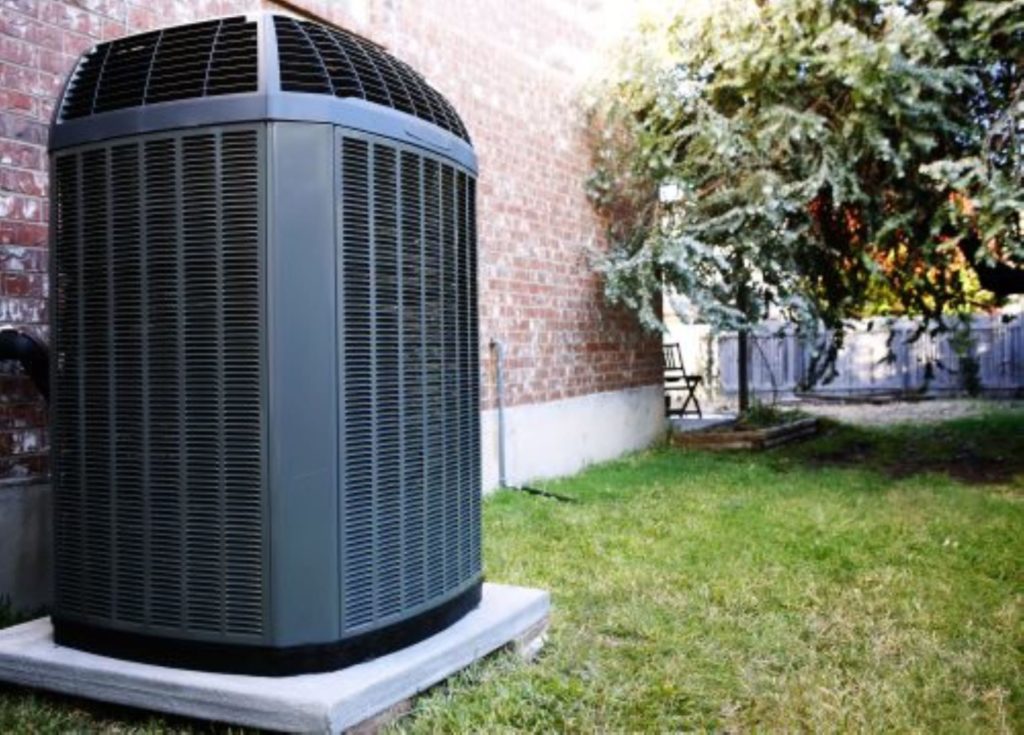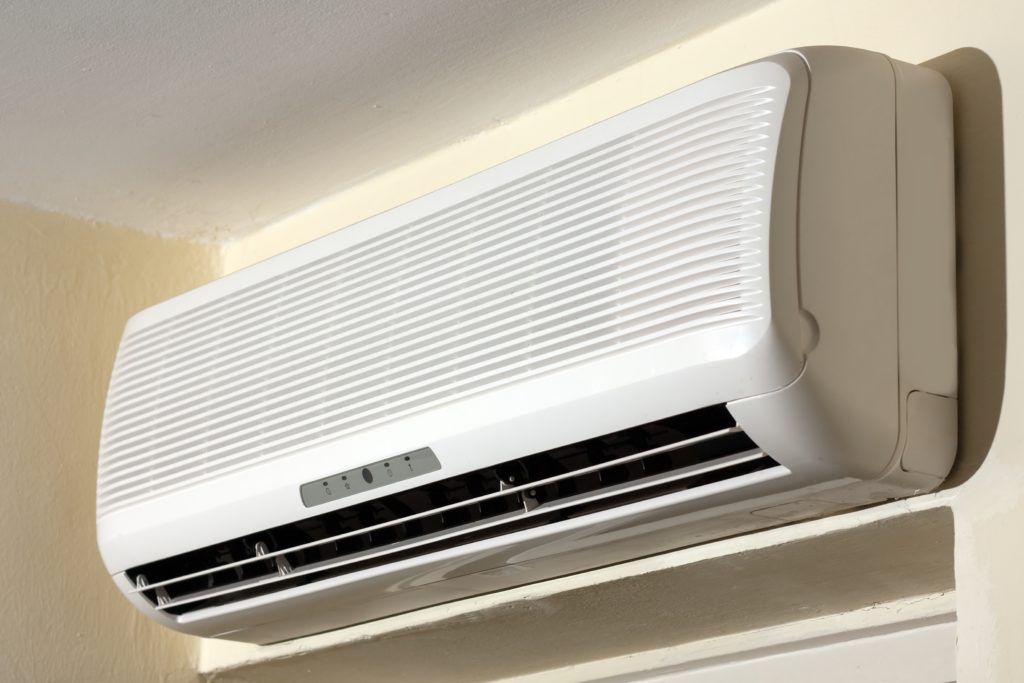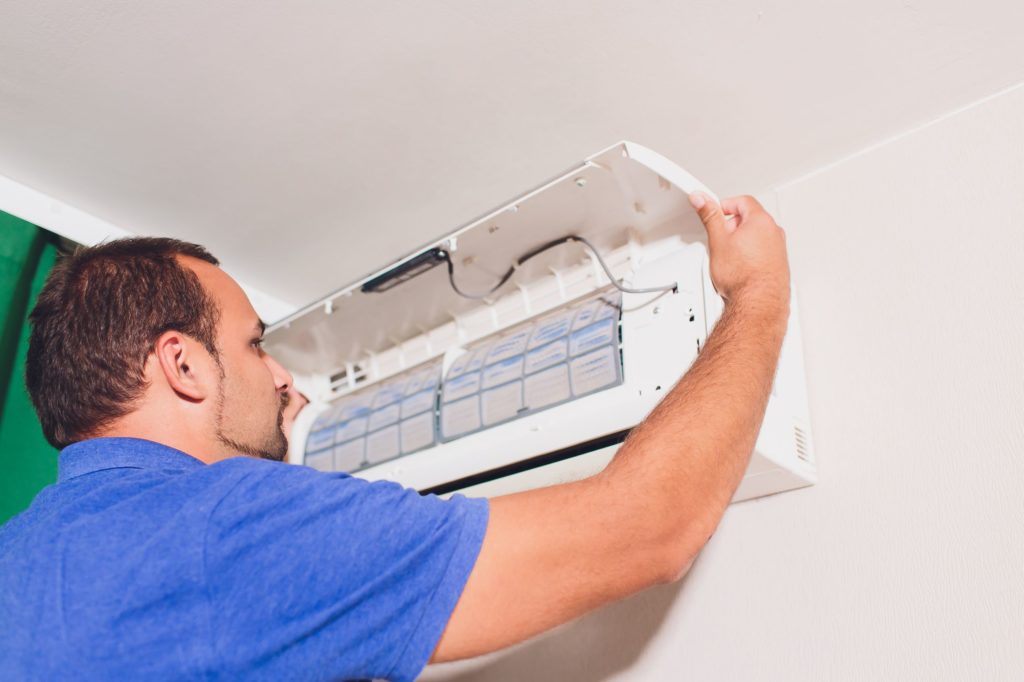Air conditioning, or AC, is a modern marvel. The unit’s main job is to lower the air temperature and dehumidify the air. Most AC units cool the indoor air through a process called the refrigeration cycle. Some AC units use evaporation or free cooling to reduce the temperature of the room.
Major Components
An air conditioner system is comprised of many components. Here we introduce the five major components used in all A/C systems:
- Thermostat – Monitors and regulates temperature
- Evaporator – Receives the liquid refrigerant
- Condenser – Helps with the heat transfer
- Expansion valve – Regulates refrigerant flow into the evaporator
- Compressor – A pump that pressurizes refrigerant
To understand where all of these parts are located, think of the entire AC unit as two coils: a cold coil and a hot coil. On the cold side, the evaporator and a fan blows air over the cold coils. On the hot side, there’s the compressor, condenser, and another fan. All three vent the hot air from the compressed refrigerant out of the room. In-between both sets of coils is an expansion valve, which regulates the amount of compressed liquid refrigerant moving in to the evaporator.
Refrigeration Cycle – How Does It Work?
Before we talk about the refrigeration cycle, let’s talk about boiling water. This will help us understand the basics of thermodynamics.
When the liquid water absorbs enough heat, the water turns into a gas. All heat tends to move from an object with a higher temperature to an object with a lower temperature. In the case of the boiling water, when the water vapor loses enough heat through contact with the cooler air or a cool surface, it turns back into a liquid. The energy, or heat, of a system tends to diminish over time.
Contrary to popular belief, air conditioning units don’t “add cooling.” Rather, the refrigeration cycle removes heat from the air inside the building. The cold refrigerant, located in the evaporator coil, absorbs the heat/energy from the warm, inside air that passes over the coil. Once absorbed, this heat and energy is released outside as the cooler atmosphere absorbs this heat coming from the condensing unit. The hot refrigerant cools off as it releases heat to the outside atmosphere and it turns back into a cold liquid, and the process starts all over.

Types Of Air Conditioners
Not all air conditioners are the same. Each system is useful for certain situations. Thankfully, we have different types of air conditioners for different styles of homes and businesses:
Split Systems
A split system keeps everything separated, splitting the hot side from the cold side. The cold side has the expansion valve and the cold “evaporator” coil. The system is placed in a furnace (or other system that handles air). The system blows air through the coil and, using ducts, guides the air throughout the building. The condensing unit is on the hot side. The unit usually sits on the outside of the building.
Ductless Air Conditioner
The popular “ductless” air conditioning system is technically a split system, and it’s sometimes called a mini-split system. You’ve probably seen a ductless air conditioning system…think of the air conditioners that are mounted on the inside wall of a room in a house or office that blow cold air into a particular part of the building. One of the least expensive HVAC system options, a ductless system has two components: an outside unit and an inside unit.
- Condenser – The outdoor unit or condenser, which contains the compressor, is installed outside your home on a concrete slab. This pumps and cools the system’s refrigerant through the copper lines to the indoor unit.
- Evaporator – The indoor unit or evaporator contains a fan that’s installed in the area to be cooled. When this fan turns, it allows the indoor coil to absorb heat from the air inside the room and it distributes the cooler air through the room.
A ductless system works the same as a regular AC unit, except there are no ducts distributing the air. Instead, the ductless system works solely through the fan installed inside the home.
Portable Air Conditioner
These units are able to fit inside most windows, and are perfect for dorm rooms, apartments, or other small spaces. The portable system uses the same principles of the refrigeration cycle, but in a tinier box. Blowers and fans move the cooled air into the room, while removing heat from the room. The refrigerant extracts heat from the air and simultaneously cools the air, creating an enjoyable experience for the user.
Packaged Air Conditioning Units
Packaged units contain all the necessary components, but they are all located in one cabinet, like a much larger version of a window unit. Instead of splitting the cold side from the warm side, they’re all together in one unit. The heating process is used through either natural gas or an electric heat lamp located inside the packaged unit. Therefore, most packaged units don’t have an indoor furnace.
Packaged Terminal Air Conditioner (PTAC) units are also known as wall-split air conditioning systems. PTAC systems are a type of packaged air conditioner that is typically installed through the wall of a building, such as a hotel room or senior living facility, so the evaporator section and controls are located inside the space and the condensing coil is on the exterior side of the wall to reject the heat from the space to the outdoor environment.

Buying A New Air Conditioner
A new air conditioner is a major expense, and shopping for one should not be taken lightly. Here are some things to consider, things to look for in an air conditioner, and reasons why prices vary from system to system.
Choosing an HVAC Contractor to Install a New Air Conditioning System
To ensure your unit will be installed correctly, hire an HVAC contractor to help you install a new AC system. When researching a quality HVAC contractor, take a look at their:
- Online reputation – A simple Google search can help find the best HVAC contractor for you. Yelp, Craigslist, and other sites are useful to see how many stars a certain contractor has.
- Service – How long do most of their projects last? Can they install your unit quickly and efficiently?
- Price – What is their quoting process? How much can you afford?
SEER Rating (Seasonal Energy Efficiency Ratio)
A SEER rating is another component you should look for in your shopping experience. Think of SEER rating like you think of miles per gallon (MPG) on your car. Higher MPG means you spend less money on fuel. In the same way, a high SEER rating correlates with a more energy-efficient unit. It’s calculated by measuring the total BTU’s (British Thermal Unit) of heat rejected per hour and dividing it by the watts of electricity used to reject that heat.
The above graph represents the lifetime energy cost of operating an AC unit depending on its SEER rating. The higher the SEER rating, the lower the lifetime energy cost. Even though units with higher SEER ratings cost more initially, they will save you more money over time.
Compressor Type
When looking at a unit, take a look at the type of compressor that fits your needs.
- Single-Stage – A single-stage compressor cools the home while running at full blast. Because this compressor knows only one speed, it turns on and off more frequently and always runs at peak capacity and energy usage. As a result, this type of compressor is not as energy efficient as the other compressors.
- Two-Stage – A two-stage compressor has two stages: medium and high. The high stage is for those hot and muggy days, while medium is for those milder days or overnight. The two-stage air conditioning compressor runs on a lower setting until the outdoor temperature gets too hot, when it is taking too long to cool off the inside space. Because the compressor can often run most of the year in the medium setting, it uses less energy and reduces your electric bills. It’s also more comfortable for you; by running longer at the medium compressor speed, the unit does a better job of removing humidity from the indoor air, making the space more comfortable and often allow you to raise the temperature on the thermostat a degree or two and still feel cool. This saves you money also! Depending on the SEER rating, a two-stage compressor costs more than a single-stage compressor.
- Compressor Warranty – There are two options for a warranty. You can either have a 5-year warranty or a 10-year warranty.
Condenser Fan Motor
Another variable to consider is the condenser fan motor which is a part of the outdoor condensing unit. These fans keep the AC’s compressor from being overheated. These fans also cool the super-heated refrigerant that moved through the condensing coils of the outside air conditioning unit. Through annual maintenance, you can increase the life of these motors. Instead of replacing the entire AC condenser (with costs ranging in the thousands of dollars), you can replace a fan motor for a few hundred dollars.
There are different types of condenser fan motors:
- Variable speed motor – These motors connect the motor control drive to the compressor, which can help vary the speed of the motor, depending on the air temperature. With this motor, you could save as much as 40% off the yearly energy usage of the condenser motor. It’s energy efficient because the unit can stay on the entire time on mild days, reducing the energy from shutting on and off all the time. Also, the motor starts up gradually and runs only as fast as necessary instead of full speed all the time.
- Single-stage – A single-stage condenser fan motor is like a single-stage compressor; it knows one speed, and that speed is 100% capacity. While a single stage condenser fan motor is by far the most common type, it costs more to operate and is often louder than a variable speed condenser motor.
Noise Level
Most consumers forget about how loud an AC unit can be until it’s too late. You’ll need to consider your AC unit’s noise level before you sit on your porch or deck and all you hear is the unit humming. A noisy air conditioner can interrupt your enjoyment of the beautiful sounds of nature in your back yard, and can be disruptive if you are hosting guests for a cookout and trying to have a peaceful conversation.
Decibels are the unit used to measure how loud something is. Humans can comfortably listen to sounds in the 110 decibel range or lower, but with repeated use, these sounds can result in ear damage. In other words, don’t go to rock concerts every weekend. To understand how loud an AC unit compares to other loud noises, click here for a great infographic comparing different sounds with one another.
Noise levels coming from AC units depend on:
- Fan Speed – A fan running full blast is noisier than a milder fan setting.
- Type of Unit – As of this moment, the quietest units range form 50-60 dB. The Carrier Infinity 19VS was measured at 56 dB. The Dave Lennox Signature Collection XC25 was measured at 59 dB. The quietest one so far is the American Standard Platinum ZV, coming in at 55 dB.
- Location – The noise level also depends on how far you are away from the unit and where the unit is located outside your home. If the condensing unit is on the opposite end of the house it might not be a big issue.
If you want to decrease the noise level of your air conditioning, here are some features that can reduce your AC’s noise level:
- Variable speed fan – The various settings allow the AC to run at quieter speeds.
- Compressor insulation – This is an enclosure that covers the compressor to reduce its noise.
- Noise-reducing fan blades – These blades are designed specifically to reduce noise.
- Insulated base pan – Placed underneath the AC, this reduces noise from the unit and resists corrosion from the droplets of water coming off the unit.
Refrigerant Type
Refrigerants are the key ingredient to the air conditioning soup. They make air conditioning possible. In general, there are two major types of refrigerants for residential applications today:
- R-22 – No, this is not R2-D2 from Star Wars, but refrigerant type R-22. You might know this refrigerant as Freon. This type is obsolete today; it’s being phased out because of growing environmental concerns.
- R-410A – The current standard, R-410A, contains no chlorine, which makes it ozone-friendly. This refrigerant has a higher pressure than Freon, and compressors that use R-410A have thicker metals to withstand the higher pressure needed to operate.
Brands
Here at Arpnet.us, we don’t favor any particular brand. There are many high-quality brands of heating and air conditioning equipment to consider, and they will all keep your home warm in the winter and cool in the summer. Our advice is to focus more on the people installing the system, rather than the brand. Brand research can be time-consuming and consumer reviews can be confusing and misleading – often the reason that a particular system did not work well for someone is because it was not installed properly by a well-trained HVAC contractor. Some of the popular brands include Lennox, Trane and Carrier, but we recommend that you focus first on finding a trustworthy local contractor who knows his brand so you don’t have to do the research.
If you need help with your air conditioning unit, check out Brubaker Air Conditioning and Refrigerant Services.
Air Conditioner Maintenance
Finally, we come to the maintenance section. To ensure cost savings on your energy bill and avoid frequent breakdowns and repair costs, do these routine maintenance checks:
Filters
Your AC unit’s filters are the most important part to maintain. You must routinely replace or clean filters because dirty filters will block the airflow in the system, reducing the system’s efficiency or causing the system to freeze up and stop working. Plus, you’ll want to avoid a situation where the dirt in the ductwork gets directly into the evaporator coil and impairs the coil’s heat-absorbing capacity.
There are many different types of filters, each with their own efficiency rating. For optimal performance, you should clean or replace them on a regular basis according to the filter manufacturer’s recommended schedule. If you’re constantly running your AC unit, if your house is close to dirt roads, or if you have furry pets, replace your filters more often.
Coils
The two coils collect dirt all the time. If a coil is dirty, it will reduce the airflow and insulate the coil, which reduces its ability to absorb or reject heat. The cool evaporator coils and the hot condenser coils need cleaning on a yearly basis. But, the coils can be cleaned less if your filters are cleaned regularly, as a clean filter prevents the evaporator coil from soiling quickly. Clean around the coils where debris and foliage can collect to allow for adequate airflow.
Coil Fins
These thin pieces of aluminum are on the evaporator and condenser coils. They’re easy to bend and can block airflow if not straightened. Purchase a “fin comb” to comb the fins back into their original position.
Condensate Drain
You need to clean the condensate drain line, which is connected to the indoor evaporator coil, to make sure water can drain properly. This can be done by passing a stiff wire through the drain pipe or blowing through the pipe.
More than Simple Maintenance
Even after you’ve done these simple steps to maintain your AC unit, there might be more problems you haven’t considered. A good HVAC technician can do any of the following:
- Check for correct amount of refrigerant
- Test for leaks
- Measure airflow through the evaporator coil
- Check the accuracy of the thermostat
- Oil motors and check belts for tightness and wear

Summary
Thank goodness for air conditioners. The amazing combination of technology that makes up the air conditioning system allows us to live through the hot weather in comfort.
There’s a lot to learn about how air conditioners work, the benefits of certain types or brands, and proper maintenance techniques. The good news is that we don’t all have to be experts.